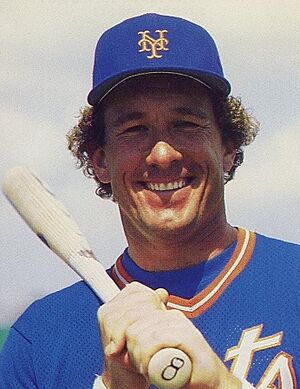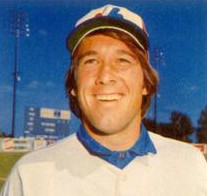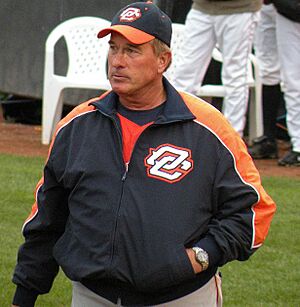Gary Carter facts for kids
Quick facts for kids Gary Carter |
|||
|---|---|---|---|

Carter with the New York Mets, c. 1986
|
|||
| Catcher | |||
| Born: April 8, 1954 Culver City, California, U.S. |
|||
| Died: February 16, 2012 (aged 57) Palm Beach Gardens, Florida, U.S. |
|||
|
|||
| debut | |||
| September 16, 1974, for the Montreal Expos | |||
| Last appearance | |||
| September 27, 1992, for the Montreal Expos | |||
| MLB statistics | |||
| Batting average | .262 | ||
| Hits | 2,092 | ||
| Home runs | 324 | ||
| Runs batted in | 1,225 | ||
| Teams | |||
|
|||
| Career highlights and awards | |||
|
|||
| Induction | 2003 | ||
| Vote | 78.0% (sixth ballot) | ||
Gary Edmund Carter (April 8, 1954 – February 16, 2012) was an American professional baseball catcher. He played for 19 years in Major League Baseball (MLB). Most of his career was spent with the Montreal Expos and New York Mets. People called him "The Kid" because of his youthful energy. Carter was chosen as an All-Star 11 times. He was also a key player for the 1986 World Series Champion Mets.
Carter was known for his great hitting, strong defense, and ability to work well with pitchers. He was also a leader on the field. In the 1986 World Series, he made important plays. This included a hit in the 12th inning that won Game 5 of the NLCS. He also had a hit in the 10th inning of Game 6 of the World Series. This hit helped the Mets start their comeback rally. He is one of only four players to be named captain of the Mets. The Expos team retired his jersey number.
After his major league career, Carter coached baseball at different levels. In 2003, he was inducted into the National Baseball Hall of Fame in Cooperstown, New York. Carter was the first player in the Hall of Fame whose plaque shows him as a member of the Montreal Expos.
Contents
Early Life and Baseball Start
Gary Carter was born in Culver City, California in 1954. His father, Jim, worked with aircraft. His mother, Inge, passed away from leukemia when Gary was 12. Gary was a talented athlete from a young age. In 1961, he won a national "Punt, Pass, and Kick" competition for 7-year-olds.
He went to Sunny Hills High School in Fullerton, California. There, he played football as a quarterback and baseball as an infielder. He graduated in 1972. He also played American Legion Baseball. In 1971, he was named the American Legion Graduate of the Year.
Carter received many scholarship offers for football. He planned to play for the UCLA Bruins. But then, the Montreal Expos picked him in the 1972 MLB draft. He decided to sign with the Expos instead.
Playing Career Highlights
Starting with the Montreal Expos
The Montreal Expos first drafted Carter as a shortstop in 1972. But in the minor leagues, the Expos changed his position to catcher. He got his nickname "The Kid" during his first spring training with the Expos in 1974.
Rookie Season and Early Success
In 1974, Carter hit 23 home runs and had 83 runs batted in for the Expos' Triple-A team. He made his first major league appearance on September 16, 1974, against the New York Mets. He finished that season batting an impressive .407. His first MLB home run was on September 28 against Steve Carlton.
In his rookie season (1975), Carter played both right field and catcher. He was chosen for the National League All-Star team as a right fielder. He hit .270 with 17 home runs and 68 runs batted in. He won the Sporting News Rookie of the Year Award. He was also named Expos Player of the Year multiple times.
Becoming a Star Catcher
By 1977, Carter became the main catcher for the Expos. He hit 31 home runs and had 84 RBIs that year. In 1980, he hit 29 home runs and drove in 101 runs. He also won the first of three Gold Glove Awards for his excellent defense. He finished second in the NL MVP voting that season.
Carter caught a no-hitter thrown by Charlie Lea in 1981. This was during the strike-shortened season. He also played in the 1981 All-Star Game. He hit two home runs in that game, earning him the MVP award. He is one of only five players to hit two home runs in an All-Star Game.
The Expos won their division in 1981. In the playoffs, Carter batted .421 with two home runs. The Expos won the division series. However, they lost to the Los Angeles Dodgers in the NLCS.
Canada's Prime Minister, Pierre Elliott Trudeau, once joked about Carter's popularity. He said he was "happy that I don't have to run for election against Gary Carter."
1984 Season and Trade
In the 1984 All-Star Game, Carter hit a home run. This helped the NL win the game. He earned his second All-Star Game MVP award. In 1984, Carter had personal bests with 106 RBIs (leading the NL) and 175 hits.
The Expos finished fifth in their division in 1984. After the season, the Expos traded Carter to the New York Mets. This trade happened in December 1984.
Joining the New York Mets

In his first game with the Mets on April 9, 1985, Carter hit a home run in the 10th inning. This gave the Mets a 6–5 win on Opening Day. The Mets and St. Louis Cardinals competed closely for the division title. Carter hit a career-high 32 home runs and had 100 RBIs. The Mets won 98 games but finished second in their division.
1986 World Series Champions
In 1986, the Mets had an amazing season, winning 108 games. They easily won their division. Carter struggled a bit in the NLCS. But he hit a game-winning single in Game 5. He also had two hits in Game 6, which the Mets won in 16 innings.
The Mets went on to win the World Series in seven games against the Boston Red Sox. Carter batted .276 and had nine RBIs in his first World Series. He hit two home runs over Fenway Park's famous Green Monster in Game 4. He is the only player to hit two home runs in both an All-Star Game and a World Series game. Carter also started a key rally in the 10th inning of Game 6. He scored the first of three Mets runs that inning.
Later Years with the Mets
In 1987, Carter batted .235. By May 1988, he had 299 career home runs. He hit his 300th home run on August 11, 1988. During this time, Carter was named co-captain of the team with Keith Hernandez.
Carter ended 1988 with 11 home runs and 46 RBIs. This was his lowest total since 1976. He also broke the career record for most putouts by a catcher. The Mets won 100 games that season. However, they lost to the Los Angeles Dodgers in the NLCS. In November 1989, the Mets released Carter after five seasons.
After the Mets
After leaving the Mets, Carter joined the San Francisco Giants in 1990. At 36, he batted .254 with nine home runs. In 1991, he played for the Los Angeles Dodgers. The Dodgers finished just one game behind the division leaders.
Carter returned to Montreal for his final season in 1992. Even at his age, teammates still called him "the Kid." In his very last at-bat on September 27, 1992, he hit a double. This hit drove in a run and was the winning hit of the game. He received a standing ovation. The Expos finished second in their division that year.
Career Statistics and Achievements
Over his 19-year career, Gary Carter was an 11-time All-Star. He won three Gold Glove Awards and five Silver Sluggers. He played in 2,296 games. He had 2,092 hits and a .262 career batting average. He also hit 324 home runs and had 1,225 runs batted in.
He hit 307 home runs as a catcher, which ranks him seventh all-time for that position. His 1,225 career RBIs also rank him seventh among major league catchers. Carter played 2,056 games as a catcher, ranking him fourth all-time. He caught 127 shutouts, which is sixth all-time for catchers.
He led National League catchers many times in putouts, assists, and caught stealing. His 810 runners caught stealing are the most for any major league catcher since 1920. His fielding percentage was .991, which was better than the league average.
Life After Playing Baseball
After retiring as a player, Carter worked as a TV analyst for the Florida Marlins from 1993 to 1996. He also appeared in a movie called The Last Home Run (1998).
Hall of Fame Induction
 |
|
| Gary Carter's number 8 was retired by the Montreal Expos in 2003. |
Gary Carter was elected to the Baseball Hall of Fame in 2003. He was the first Hall of Famer whose plaque shows him wearing a Montreal Expos cap. Carter had played 11 years in Montreal. The Hall of Fame decided that his biggest impact was with the Expos. Carter accepted this decision with grace. He said it was right because most of his achievements were with the Expos.
At his induction ceremony, Carter thanked fans in Montreal. He also mentioned the Mets' 1986 championship as a highlight of his career.
Carter was inducted into the New York Mets Hall of Fame in 2001. The Mets have not retired his number 8, but no player has worn it since 2003. In 2001, he was also inducted into the Canadian Baseball Hall of Fame. His number eight was retired by the Expos. After the Expos moved to Washington, D.C., a banner with Carter's number was hung at the Bell Centre in Montreal.
Coaching Career
Carter started managing in the minor leagues in 2005. He was named Gulf Coast League Manager of the Year in his first season. In 2006, he led the A-level St. Lucie Mets to a championship. He also earned Manager of the Year honors for that league.
In 2008, he managed the Orange County Flyers in the Golden Baseball League. He led them to a championship and was named Manager of the Year. The next season, he managed the Long Island Ducks. In October 2009, Carter became the head baseball coach for Palm Beach Atlantic University.
Personal Life and Legacy
Gary Carter met his wife, Sandy, in college. They married in 1975 and had three children. His daughter, Kimmy, was a college softball catcher and later a coach.
Carter was very active in charity work. He supported causes that fought leukemia and promoted reading. The Gary Carter Foundation helps schools in poor areas. It encourages reading programs for children.
Illness and Passing
In May 2011, Carter was diagnosed with brain tumors. Doctors found a serious type of brain cancer called glioblastoma multiforme. The cancer was inoperable. Carter underwent other treatments.
Gary Carter passed away on February 16, 2012, at age 57. Nine days later, the Mets announced they would wear a memorial patch on their uniforms for the 2012 season. The patch had a black home plate with the number 8 and "KID" on it.
The NHL's Montreal Canadiens also honored Carter. They showed a video and had a moment of silence. All Canadiens players wore number 8 Carter jerseys during warm-ups.
Many people remembered Carter's positive attitude. Baseball writer Tom Verducci said he could not imagine Gary Carter without a smile. He played with joy every day. At Carter's memorial service, his former teammate Tommy Hutton spoke about Carter's strong faith. He said Carter's three loves were his family, baseball, and God.
A street in Montreal, near the former Jarry Park, was renamed Gary Carter Street in his honor. In 2014, a banner honoring Carter was unveiled at Olympic Stadium in Montreal. It reads "Merci! Thank You!" and shows his retired number 8.
More About Baseball
- DHL Hometown Heroes
- List of Gold Glove Award winners at catcher
- List of Silver Slugger Award winners at catcher
- List of Major League Baseball annual runs batted in leaders
- List of Major League Baseball career hits leaders
- List of Major League Baseball career home run leaders
- List of Major League Baseball career runs scored leaders
- List of Major League Baseball career runs batted in leaders
- List of Major League Baseball career double plays as a catcher leaders
- List of Major League Baseball career games played as a catcher leaders
- List of Major League Baseball career putouts as a catcher leaders



